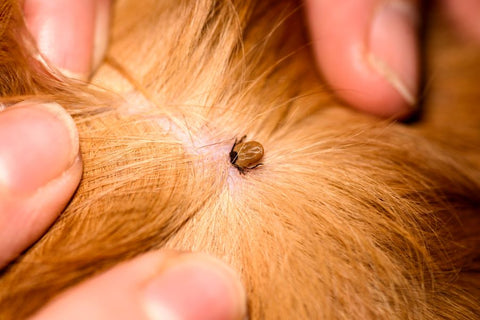

Protect Your Pets: Lyme Disease in Dogs & Cats
Lyme disease is a serious illness spread by ticks. It mainly affects dogs and, less often, cats. If you don’t treat it, Lyme disease can cause joint pain, kidney failure, and other problems like neurological issues, including seizure disorders. The good news is that you can protect your pet from Lyme disease. If an infection happens, knowing the signs will help you catch it early.
What is Lyme Disease?
Lyme disease happens because of the Borrelia burgdorferi bacteria, also called the Lyme disease bacterium. These bacteria spread when an infected blacklegged tick, or deer tick, bites. Dogs are more likely to get Lyme disease than cats. However, outdoor cats in places with many ticks can also be at risk.
Symptoms of Lyme Disease in Dogs & Cats
Pets might not show clinical signs right after a tick bite. The disease can take several weeks or even months to appear. Common signs to look for include:
In Dogs:
-
Limping or lameness (which can change between legs)
-
Swollen joints or stiffness
-
Fever
-
Tiredness or lower energy
-
Loss of appetite and/or weight loss
-
Sensitivity to touch
-
Swollen lymph nodes
In Cats:
Lyme disease is rare in cats. However, there are some signs of illness you should watch for:
-
Feeling very tired
-
Not feeling hungry and/or losing weight
-
Limping or feeling stiff
-
Having a fever
If you think your pet might have Lyme disease, it's important to see your vet. This is especially true if your pet has been around ticks. Symptoms can be unclear, so getting professional help is a good idea.
Diagnosis of Lyme Disease in Pets
Lyme disease is found through a blood test that looks for antibodies against the Borrelia burgdorferi bacteria. If your pet tests positive, your vet might suggest more diagnostic tests. These tests help to check how bad the infection is and what the best treatment options are.
articleproducts1
The Transmission Mechanism of Lyme Disease
Lyme borreliosis spreads through the bite of blacklegged ticks that have the Borrelia burgdorferi bacteria. These small ticks attach to hosts like domestic animals such as dogs or cats. They can pass on the bacteria while they feed. Knowing how this transmission works is important for preventing Lyme disease in pets.
How to Prevent Lyme Disease in Pets
Lyme disease can be harmful, but the best way to fight it is to prevent it. Taking steps to stop it is very important! Here are some ways to keep your pets safe:
Tick Prevention Tips:
-
Use vet-approved tick preventatives – You can choose from creams, pills, or collars to keep ticks away.
-
Try natural DIY remedies - There are many natural options to prevent ticks (and fleas!).
-
Check your pet daily – After walks, hikes, or playing outside, look through your pet’s fur, ears, and paws for ticks.
-
Keep your yard tick-free – Mow the lawn often, clear away leaves, and trim bushes to lower tick hiding spots.
-
Limit exposure to tick-prone areas – Stay away from tall grass, wooded areas, and places with a lot of deer when you do outdoor activities.
Safe Tick Removal Techniques
When you're dealing with Lyme disease in pets, preventing it is the best approach. But what should you do if you find a tick on your pet despite all your efforts to stop it? Let's talk about how to safely remove these pesky ticks from your dear pet.
If you find a tick on your pet, here are safe ways to remove it:
Use fine-tipped tweezers to hold the tick as near to the skin's surface as you can.
Pull up with steady and even pressure. Do not twist or jerk. This will help to prevent breaking the mouthparts.
-
Wash the bite area and your hands using rubbing alcohol or soap and water.
Vaccination for Lyme
Some dogs, especially those in areas where Lyme disease is common, might need the Lyme disease vaccine. You should ask your vet if it’s a good choice for your dog. Sadly, there is no vaccine like this for cats.
Treatment Options for Dogs and Cats
If your pet has Lyme disease, don't worry! It can be treated, especially if it is discovered early.
Treatment for Dogs:
-
Antibiotics – Many dogs get better with a 4-week treatment of antibiotics, like doxycycline or amoxicillin.
-
Pain relief – A vet might give anti-inflammatory drugs for pain and stiffness in the joints.
-
Supportive care – Supplements that help the immune system and joints, such as Prana Pets’ Hip & Joint Immunity Regimen, can aid in recovering.
Treatment for Cats:
Cats with this disease can be treated with antibiotics, although this is not common.
articleproducts2
Alternative and Complementary Treatments
Along with the usual antibiotic treatment options, other treatments can help manage Lyme disease in dogs. The duration of treatment with holistic methods like acupuncture, herbal remedies, and homeopathic treatments may support the immune system and reduce inflammation caused by the disease. It's important to talk to a holistic veterinarian who is skilled in treating Lyme disease to find the best plan for your dog. Using both conventional medicine and alternative therapies can give a complete approach to your pet's healing journey.
Geographic Prevalence of Lyme Disease
Different parts of the country have different risks for your pet to get Lyme disease. The Northeast, Upper Midwest, and Pacific Northwest have more cases of Lyme disease in dogs. This is due to ticks that carry the bacteria. Pet owners in these areas need to be careful. They should use tick repellents, check their pets for ticks often, and clear ticks from around their home.
Some areas in the United States where there are lower levels of Lyme disease in pets are the Southwest and Southeast. Even though the risk is lower here, pet owners should still be careful. They need to take steps to protect their pets from tick-borne diseases. It is important to visit your veterinarian and keep a routine for tick prevention. These are key actions to keep your pet healthy and safe. Always remember, taking care of your pet before problems arise is better than treating them after.
Long-term Effects and Management of Chronic Lyme Disease in Pets
Lyme disease can have long-lasting effects on your pets. This can include issues like joint pain, kidney problems, and nerve issues. Managing chronic Lyme disease in pets requires ongoing care from the vet, changes in diet, and adjustments in their daily routines. Regular vet check-ups, keeping an eye on kidney health, giving joint supplements, and making sure your pet eats a balanced diet can help ease their symptoms. This will also improve their quality of life. It’s important to work closely with your vet to create a care plan that fits your pet's needs. This will help them live a happy and comfortable life even with their condition.
Zoonotic Risk: Can Humans Contract Lyme from Pets?
Another big question about Lyme disease is if we can get it from our pets. The answer is yes, humans can catch this from pets. It is not common for pets to pass it directly to humans. However, the main worry is that both can be in the same place and get bitten by the same infected adult ticks.. This means pet owners in Lyme-affected areas, like the eastern United States, should take steps to stay safe. They should use tick prevention on their pets, check them for ticks often, and keep their yards tick-free. This helps protect both themselves and their pets. Also, finding Lyme early and treating it quickly is important to stop it from spreading between pets and their human families.
Lyme disease in dogs and cats can be very serious. However, you can keep your pet happy and healthy with good prevention, early detection, and quick treatment. Regularly checking for ticks and using good tick prevention products are the best ways to protect your furry friend from infection.
Want to help your pet's immune system in a natural way? Check out our herbal and homeopathic supplements. They are made to support your pet's overall health and wellness!
FAQs about Lyme Disease in Pets
Here are some common questions people ask about Lyme disease in dogs, cats, and other pets:
Q: Can humans contract Lyme disease from pets?
A: Yes, people can catch this sickness from pets when they come into contact with the same infected ticks in places they share. Using tick prevention products and checking regularly are very important to lower the chance of spreading it.
Q: How can I protect my pet from Lyme?
A: Keep your pet safe by using tick products, checking them often for ticks, and keeping your yard free of ticks.
Q: What are the usual signs of Lyme disease in pets?
Common signs are limping, swollen joints, fever, feeling tired, and loss of appetite. If you see any of these signs, please talk to your veterinarian for testing and treatment.
articlebanners1




